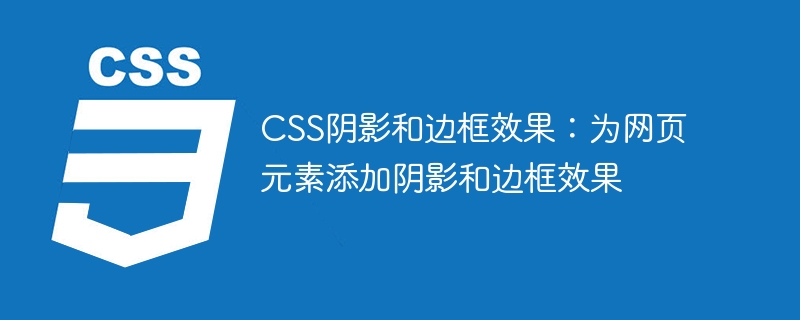

CSS Shadow and Border Effects: Add shadow and border effects to web elements
In modern web design, it is important to create an impressive and well-readable The unique page elements are a very important part. Among them, CSS shadow and border effects are one of the commonly used technical means. By adding shadows and borders, we can make page elements more eye-catching and layered. This article will introduce how to achieve these effects through CSS code and give specific code examples.
1. Shadow effect
h1 { text-shadow: 2px 2px 4px #888; }
This code will add a 2 pixel horizontal offset, 2 pixel vertical offset, and 4 pixel blur to the text within theh1tag shade with color #888.
div { box-shadow: 4px 4px 8px #888; }
This code will bediv Theelement adds a shadow with a horizontal offset of 4 pixels, a vertical offset of 4 pixels, a blur of 8 pixels, and a color of #888.
2. Border effect
div { border-style: solid; border-width: 2px; border-color: #888; }
This code will add a 2 pixel wide border of #888 color to thedivelement.
div { border-radius: 10px; }
This code will add a 10-pixel rounded corner effect to thedivelement.
div { border-image: url(border.png) 30 30 round; }
This code will add an image named border.png as a border style to thedivelement and set a 30 pixel wide image bevel.
Comprehensive application example:
div { border: 2px solid #888; box-shadow: 4px 4px 8px #888; border-radius: 10px; margin: 20px; padding: 10px; }
The above code will add a 2-pixel wide border to thedivelement with a color of #888 and a shadow effect of 4 pixels horizontal offset , Vertical Offset 4 px, Blur 8 px, Color #888, Rounded Corners 10 px, Margins 20 px, and Padding 10 px.
Summary
Through the above code examples, we learned how to add shadow and border effects to web page elements through CSS. Shadow effects can be applied to text and elements themselves, while border effects can be achieved by setting attributes such as border styles, rounded corners, and images. By skillfully using these techniques, we can add more visual effects to web design and improve user experience.
The above is the detailed content of CSS shadow and border effects: Add shadow and border effects to web elements. For more information, please follow other related articles on the PHP Chinese website!